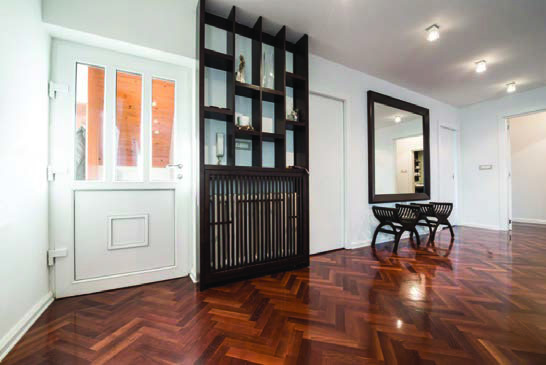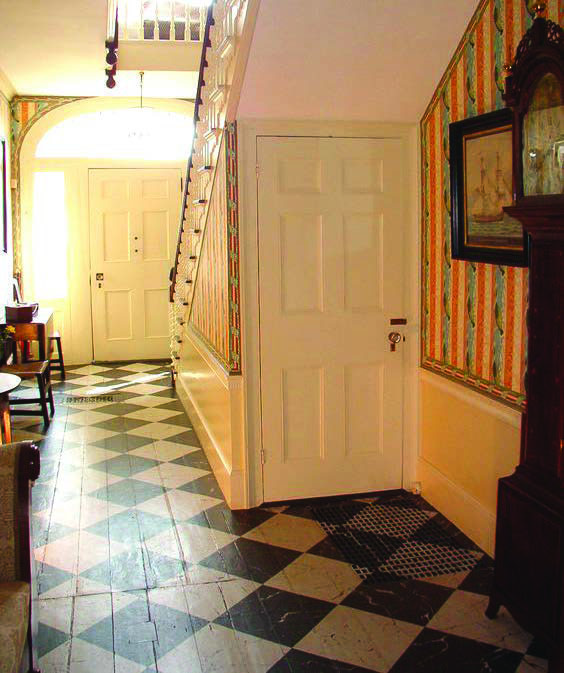When I first bought a home, the floors were what the wood floors were—skinny, brown oak strips. That was it. And I never thought twice about changing it up.
It wasn’t until I was invited to participate in the prestigious Kips Bay Designer Showhouse that I was circuitously exposed to other flooring options. (How, you might ask, was a neophyte suburban decorator invited into the upper echelon of design? Well, the head of the selection committee took a liking to my husband… But I digress.) Soon, big design jobs came my way, including a full-floor apartment on Fifth Avenue across from the Met with the most striking floors 5’ wide quartersawn oak floors I had ever seen.
Since that a-ha moment floors have come a long, long way.
The options are endless. And confusing: maple, fir, chestnut, walnut, red oak, white oak, engineered, pre-finished, widths that range from two-and-a-quarter inches to seven inches, quartersawn, riffed, figured or not. Yikes.
The vast majority of our floors remain the classic two-and-a-quarter inch wide oak (either red or white), sold in a mixed bundle, meaning the plank lengths are of mixed lengths, from one-foot to eight feet long. Clinton (clintonqualityfloors@aol.com, 914-320-1431), a wonderful floor guy sources from several mills for his wood floors, seeking longer plank lengths and tighter grains. A bundle that’s full of shorter lengths may be, say, fifteen cents cheaper a square foot, but all those short planks mean more labor and also a busier looking finished product.
If you happen to have that standard oak already, you are good to go; it’s the classic. But if you are building new, adding on, or swapping out a tile kitchen floor for hardwood, then the decision-torture really begins.
In a home I am currently working on in Larchmont Woods, we are keeping the classic two-and-a-half inch oak in the bedrooms, living, dining and study. But for the newly double-height entry, we’re using the same oak in a different way. Herringbone, as I am sure you are aware, is having a very big moment—and in this Mediterraneanish home, a carefully placed chevron pattern draws the eye away from the different generations of wood. We call that match and patch—when you feather in new boards with old boards during the inevitable damage renovation process. In the kitchen/family/eating area, we are transitioning to a four-inch quarter-sawn oak. Using a variation on the size and graining of the oak, gives us license to change the stain color. Like things need to be alike. Different things can dare to be different.
The homeowner was tempted to go even wider, but planks over four inches need to be nailed and glued as they’re prone to cupping (nailing/gluing equals additional labor/cost). Whenever the budget allows, I recommend quarter sawn and riffed wood cuts—the grain is tight, there are no arches or cathedrals or knots. I love it. Remember installation and finishing costs don’t go up; it is only the cost of the wood itself.
Prefinished or factory-finished floors save time and labor costs, but they have defining characteristics I don’t like, notably a bevel joint between planks. Yuck. Fine for a playroom or basement space, but otherwise I’d pass. For a (substantial) upcharge, you can find premium prefinished boards that sit tight together without the dreaded bevel—and there are times and scenarios when a prefinished floor is the only real choice. Longtime clients, now living in a contemporary home in the woods of New Hampshire, used such a floor (a quarter-sawn prefinished floor by Carlisle); they had to lay the boards over a concrete floor imbedded with radiant heating and were unable to do the typical nail-down floor. It is magnificent.
But most clients—and most homeowners—end up installing floors that are not prefinished. And thus the finishing of floors becomes a cause célébre. Normally decisive customers become suddenly needy, in part because the color range is endless. For many, gray is still reigning supreme. Duraseal has a range of grey stains or you can concoct your own using white and ebony or white and dark walnut and so on. For those who hew to the more traditional colors, my go-tos are Dark or Special Walnut. Oft with a splash of Provincial. For lighter looks I am loving the new Minwax Weathered Oak. But the only way to know for sure is to test—and test again. Any good installer will mix up a range of stains for you. Do know, though, that it’s important to view the stains while wet as that’s how they will look with polyurethane on them. (Once dry, the raw stained wood looks pasty.)
As important as the choice and quality of your wood is the finishing process. Clinton notes that too many installers just vacuum and then urethane atop, leaving dust and bubbles on the surface of the floor. Rather, he recommends going “old school” and using a Pack Cloth post-vacuuming to get up ALL the dust and debris.
If the existing wood is really beat up, or you’re looking to marry two not-quite-right species together, you could always go all Swedish Country and paint the floor. Deck or porch paint is far more durable than standard issue. In a center-hall colonial in Larchmont we painted the floor of a young girl’s rather dark room a bright matte white, and years later the finish was still going strong. In a house in the Hudson Valley, we painted the hall and stairs where no less than 4 different species intersected, Briarwood, an exterior color. And each time I walk into that house, I’m reminded of the long-life and long charm of wood.



